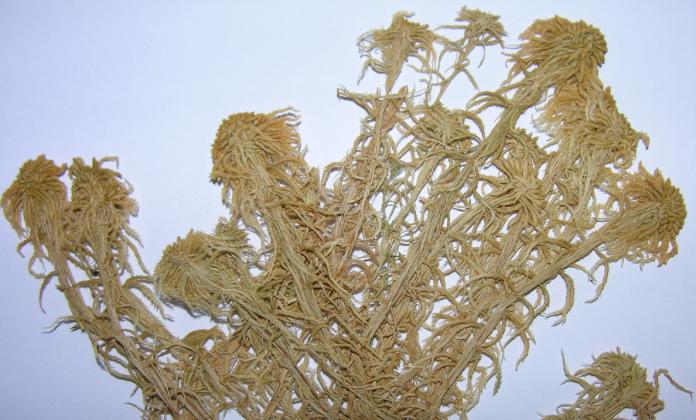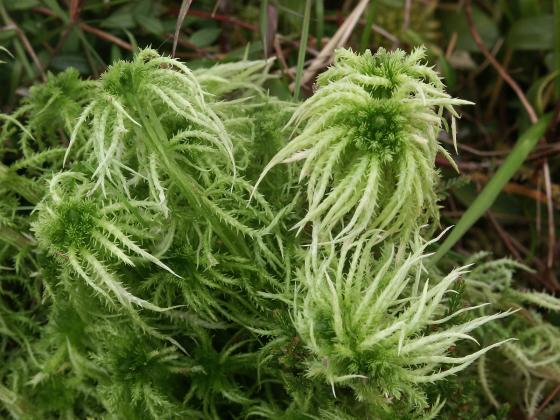Sphagnum moss - Gardening, WWI bandages, more
Backyard Horticulture
Most gardeners have encountered some of the almost 400 plants in the Sphagnum genus as a soil conditioner in potting and garden soils. Sphagnum mosses, Sphagnum spp., live on top of watery bogs in cooler climates not found in Grimes County, Texas. The name is from Greek, sphagnos, a kind of moss. They have a green main stem with other stems clustered around it called fascicles. There are small tubes throughout, sponge-like. Brown when dried, it can hold more than 20 times its weight in water.
Before proceeding, I need to deal with semantics. Sphagnum moss is one of the many species that spreads on a bog surface in mats. When it dies, the dead material, called sphagnum peat moss, sinks beneath. Peat is a generic term. Other plants have similar life cycles and their dead material is also called peat when it sinks in a bog. Different countries may refer to sphagnum peat moss as peat or peat moss. Manufacturers may have other names. It can be confusing so when you purchase it, you’ll have to read the label.
This article is about Sphagnum spp., sphagnum moss, the plant that was alive on top of the bog before harvesting and sphagnum peat moss, the dead layer which can range from a few inches to 20-feet deep or more. It took thousands of years to create some bogs. Because of its acid environment, 10,000-year-old well-preserved artifacts have been found.
There are bogs in a few places in the U.S. but 80% of sphagnum peat moss used in the U.S. comes from Canada. There is controversy about harvesting sphagnum peat moss. Some say it’s a renewable resource because it forms constantly in the bogs. Others say it is not renewable because the bog must be drained to obtain it and natural regeneration is not possible as it took hundreds or thousands of years to build.
Sphagnum spp. is naturally anti-microbial and is excellent at wicking away moisture. It has more uses than just gardening:
• Used to clean septic tanks in areas without the normal means.
• Alternative to chlorine in swimming pool sanitation.
• Used to grow mushrooms.
• Packing for seeds and live plants in shipping.
• Used for diapers by Native Americans and others.
• Sfag-Na-Kins were sphagnum moss sanitary napkins made ca 1919 to 1920.
• Packing material for protecting delicate items in transit.
• Insulation.
• Cut into bricks and used for heating and cooking.
• Treatment of skin issues such as insect bites, eczema, psoriasis, etc.
• Wounded animals such as reindeer will drag themselves to a sphagnum moss bog.
• Used as a healing bath in some spas.
The plant’s usefulness in wound care has probably been known for millennia but was rediscovered on the battlefields of Europe during World War I (July 1914 to November 1918). The article “How Humble Moss Healed the Wounds of Thousands in World War I” at the Smithsonian magazine site, smithsonianmag.com , told how Sphagnum spp. helped the wounded when there was a shortage of cotton. “In the last months of 1914, doctors like Sir. W. Watson Cheyne of the Royal College of Surgeons of England noted with horror the ‘great prevalence of sepsis’, the potentially life-threatening response triggered by a bad infection. And by December 1915, a British report warned that the thousands of wounded men were threatening to exhaust the material for bandages … But in the end, there simply wasn’t enough cotton—a substance that was already in high demand for uniforms and its recently discovered use as an explosive—to go around.”
The explosive referred to guncotton, nitrocellulose. In the mid-19th century a discovery showed how cotton soaked with certain chemicals could be weaponized. Armies used guncotton for some weapons as it was more powerful than gunpowder, left no residue and produced no smoke.
The article continued, “In ancient times, Gaelic-Irish sources wrote that warriors … used moss to pack their wounds … In 1916, the Canadian Red Cross Society in Ontario provided over 1 million dressings, nearly 2 million compresses and 1 million pads for wounded soldiers in Europe, using moss collected from British Columbia, Nova Scotia and other swampy, coastal regions. By 1918, 1 million dressings per month were being sent out of Britain to hospitals on continental Europe, in Egypt and even Mesopotamia. Communities around the United Kingdom and North America organized outings to collect moss so the demand for bandages could be met.”
The National Institutes of Health, ncbi.nlm.nih.gov, has more information about the plant’s role in WWI including the part played by the American Red Cross in their article “Sphagnum Moss For Use As A Surgical Dressing; Its Collection, Preparation and Other Details.”
Deborah Richardson is a freelance reporter for The Examiner with a fondness for flora in its natural setting.


